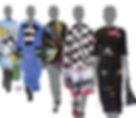How has Pop Art Influenced Us?
- Ishika Paruthi
- Jul 17, 2020
- 3 min read
Updated: Feb 22, 2022
Emerged in the UK in mid 1950s and instigated by progressive artists like Eduardo Paolozzi and Richard Hamilton, Pop Art wouldn’t be a true movement if it didn’t move across the pond to the States where artists like Andy Warhol, Roy Lichtenstein, James Rosenquist, and Claes Oldenburg redefined what would become an international phenomenon. By creating pieces inspired by mass culture, cults and everyday objects while trying to blur the lines between high art and low culture, Pop Art became one of contemporary art’s most recognizable styles, influencing music, culture and society as a whole. It has also paved a way for young artists who grew up surrounded by over saturated popular culture.

As the art world shifted from art objects to installations during the 70s, Pop Art became less popular but thanks to artists such as Jeff Koons and Takashi Murakami, who lead the way to the renaissance movement – taking inspirations from objects that are not usually considered art such as vacuum cleaners and basketballs and making way into the art galleries as “Pop –meets – ready made!
Pop Art has influenced each and everything in a number of ways and all thanks to artists such as Warhol & amp; Murakami who brought pop art into the spotlight.
1. Music:
Murakami designed the cover for Kanye West’s 2007 album, graduation where
he used his signature style and depicted a ‘dropout bear’ mascot leaving the
fictional college Universe City.

Koons handled the artwork for Lady Gaga’s 2013 album Artpop, where he
created a lifelike structure for the launch party, fusing hip hop, punk and street
culture influences.

2. Interior design:
Italian Label Seletti and manufacturer Gufram defined the cultural crossover
through aspects of graphic art and marketing.

Bold, irreverent and funny is what pop art is all about and to add that to
interiors makes a place instantly recognizable as well as tasteful. This is
probably the most recognizable artistic style in the world and it never muted.
3. Pop Art is an Attitude:
If it’s not realistic, you’re on the right track. It’s not about realism. It’s about Pop. It’s
about making things pop out and look different from the ordinary; make them
extraordinary! So, your attitude is what makes something ‘pop’. Pop isn’t always big
cartoons but making familiar things look different. Go over the top but don’t forget
COLORS. ARE. CRUCIAL.

4. Fashion:
With a long history of cross pollination, art and fashion have always collided
ever since pop art began.
Yves Saint Laurent co-founder Pierre Bergé once said the following: “fashion
is not art, but it needs an artist to create it”, and the two disciplines have
frequently forayed into each other and Warhol’s The Souper Dress was itself a
bonafide art-cum-fashion crossover, and Lichtenstein’s comic book take offs
have been favoured by all from Nike and Converse.

5. Brands/Advertising:
Murakami, having collaborated with several brands such as Vans and Louis
Vuitton to name just two—whilst Koons has collaborated with H&M, creating
a collection of bags emblazoned with his signature balloon dog.
Philip Colbert, a contemporary fashion designer who took pop;s inspiration
and ran (who earned himself the sobriquet of ‘godson of Andy Warhol’ by
Andre Leon Talley) with his Poptastic label The Rodnik Band!
Last but not at all the least, provocateur Jeremy Scott, whose junk culture-
inspired work for Moschino is as Pop as it gets.

6. Graphic Design:
Pop art has and still influences graphic design. The most. Specially in poster
art because pop art being so bright that it literally pops out is what grabs
attention and hence fits the criteria of pop art perfectly. Mostly used in
political posters, pop art and graphic design are two terms that go hand in hand
and are just a way of sending out messages through visuals. Both of their goal
is the same – to be bold and stand out from the crowd.

Pop Art still continues to thrive on the same cultural values that led to its timely genesis; as long as there is mass media there will be creativity fueled by the introspective values of your Paolozzis, Hamiltons, and Warhols. The recent example of the same being fashion weeks; Prada and Comme des Garçons were flaunting colorful and repetitive designs, whilst Donatella Versace reprinted Warhol’s works and pop art Vogue covers for the Versace catwalk show.
Pop Art looks out into the world. It doesn't look like a painting of something, it looks like the thing itself.
- Roy Lichtenstein